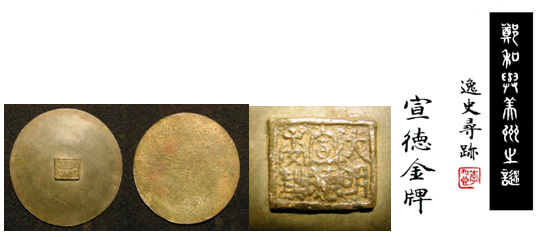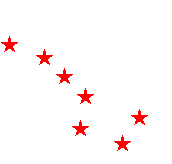Editor’s Note: The article was first published on http://www.asiawind.com/zhenghe in 2006. A copy of the lecture at the Hong Kong History Museum (June 17, 2006) is available from the museum for the public. More evidence will be included in Dr. Siu-Leung Lee’s forthcoming important lectures in 2010. A book is also under preparation.
A 7-cm diameter plain brass medallion with the inscription “Authorized and awarded by XuanDe of Great Ming” was unearthed 4 inches under the surface, several hundred miles inland from the American east coast,

In 1430, Ming Emperor Xuan Zong commissioned Zheng He to deliver a message to foreign nations that he was enthroned with a new era named Xuande. This was the whole purpose of the 7th and the last expedition for Zheng He. “Did Zheng He’s excursion reach east America? Or is there other explanation?” The owner of the disk, Dr. Siu-Leung Lee, would like to present some interesting observations and leave the conclusion to the audience.
Ming emperors had a diplomatic protocol to announce enthronement and new era by sending gifts and medallions to other nations. Xuande (1426-1435) is the Nianhao (era) of Emperor Xuan Zong, the 5th emperor of Ming dynasty. In 1430, he dispatched Zheng He to announce his enthronement. The medallion represented the highest authority of the emperor and was only delivered by a diplomat like Zheng He or his deputy. After Xuan Zong died, China isolated herself from the rest of the world for more than 400 years. Chinese started to come to America after 1850s as indenture labor mostly through the west coast to mine gold and build the railway. Few Chinese came through this part of the east coast where the railway was built exclusively by slaves and convicts. Today, this little town of 9000 has 4 Chinese by US Census in Year 2000. This brass disk is minimally decorated with little monetary or artistic value to Chinese laborers and European missionaries, who are the other possible but unlikely carriers of items from China. There should be quite a few medallions of this kind in those days, but the unused ones were usually collected, melted down and recycled by the next emperor. Those countries along Zheng He’s route all suffered from multiple wars. Items like this were easily lost in looting.
The brass medallion was discovered under 4 inches of soil in a scantly populated area several hundred miles inland from the east coast of America. After almost 600 years, the medallion shows no apparent signs of corrosion, other than a tight coating of soil. Elemental analysis of the medallion shows that the material is brass, a copper alloy with zinc. Xuande was exactly the era when brass first became available, as exemplified by the famous Xuande brass censers and coins.
The brass medallion was unearthed at the center of Cherokee Indians’ homeland that became a major battleground with the first European settlers. Hundreds of Cherokee Indians were killed in multiple battles. In 1776, right after the American Independence, the Cherokee’s land was granted to the soldiers in lieu of pension, resulting in another major battle. Could the Cherokees be the ones who lost the medallion in the war? In 1838-39, the Cherokee people were later driven more than a thousand miles away to Oklahoma in a historical event known as the “Trail of Tears”, during which thousands of Cherokee Indians died. During the colonial era, 90-95% of the Cherokee perished. But why was the medallion found inland? Did they obtain it from other tribes near the coast? This traces to another story.
The coastal tribe Catawba is well known for making pottery. There are potters in almost every family. Some of their pottery designs bear great resemblance to the tripod brass censers made in Xuande era. The Catawba and Cherokee tribes were rivalries but they also traded with each other. Could the Catawba tribe be the first to make contact with the Ming people?
Europeans, especially the English, have been trying to reproduce the Chinese porcelain for ages without success. In 1712-22, Père Francois Xavier d'Entrecolles (殷弘緒), a Jesuit missionary, was sent to China to learn about the secret of Jingdezhen (The porcelain capital of China and the world). He wrote two long letters back home detailing the methodology. However, Europeans still could not produce true porcelain for the lack of the knowledge to process the white clay. The first discovery of white clay was by Andrew Duché in America. Wedgwood, the founder of the first porcelain industry in England dispatched Thomas Griffiths to America to look for china clay. By kidnapping the chief’s wife, he was led to the white clay pit by the Cherokee chief. Tons of the white clay were shipped back to London for Wedgwood, the first porcelain factory in England. Even so, England’s porcelain was still not competitive against the Chinese imports by the entire 18th century. Yet, at the same time, pottery in North Carolina was made in Ming style by natives and new European immigrants. What took China close to 10,000 years to perfect was not so easily learned even by the technologically adept Europeans at that time. How could the Neolithic Cherokee and Catawba Indians master this technology so well?
The most fascinating fact is the Cherokee term for china clay is “unaker”, similar to what Chinese call 堊泥“uk-na[ke]” in southern dialect ([k] is silent). The Chinese name uk-nake was used in Ming dynasty. The Catawba call pottery clay “i-tu” or “i-to”, similar to 堊土, the dry material. Note that these words were transliteration of the Native languages. Their pronunciation can never be taken as 100% correct. The same is true for kaolin. Many English people pronounce it as “kay-o-lin”, rather than “gao-ling”. This term kaolin高嶺土replaced 堊泥/堊土when the white clay was exhausted. So the term is typical of Ming dynasty. It cannot be a coincidence because the Cherokee also call white color “unega”, the same sound as “unaker”, exactly as the word is defined in Chinese – white clay for making pottery. So they are using the color of the clay as the name for the color, just like we use chocolate and periwinkle to represent colors. When two separate cultures call the same material of same form and utility by the same name, there is definitely a connection. A Jingdezhen porcelain expert confirms that Zheng He brought the clay bricks (petuntse or baidunzi) along with the porcelain gifts.

The Cherokee people have two original flags, viz. one with a white background and the Bigger Dipper constellation in red that they called the peace flag. The war flag is reversed in color. Observation of constellation has been a routine in China since ChunQiu era (770-476 BC). A flag with the Big Dipper has been used as one of several flags in imperial ceremonial parade from Song dynasty (960-1127AD) up to Qing dynasty (1644-1911 AD). The Ming emperors were especially fond of the Big Dipper in association with their Daoist belief. Zheng He used an instrument 牽星板 Qian Xing Ban (Boards aligning the stars) to calculate the latitude using the Polaris and the Big Dipper. On the other hand, lacking a written language to register the celestial observations, the Cherokee people seem to have no knowledge of other constellations on record.
Ming dynasty had significant advances in brass and porcelain. The brass medallion is a specific case and pottery a general case. Could these clues change the history we have been told? The documents of Zheng He’s voyages were deliberately destroyed by a courtier. The Beijing palace also suffered from more than 100 fires from Ming to Qing. A lot of valuable documents were also lost due to looting. It is very difficult to reconstruct the history of Zheng He just from Chinese documents.
The above is a summary of a short three-month research three years ago, just after acquiring the medallion. It was not conclusive then whether Zheng He’s fleet could reach America. The research direction turned out to be correct. After three years of research, more evidence has emerged, leading to a strong conclusion: “Many events are impossible if Zheng He did not reach America. In fact, they might have visited America more than once.” The evidence will be presented in conferences in 2010. A book is now under preparation.
(Prepared 6/14/2006, modified 7/4/2006, 12/7/2009)
|